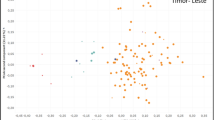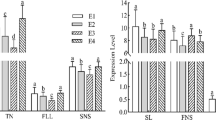Abstract
The availability of a genetically diverse gene pool is vitally important in varietal development. Molecular markers are being extensively utilized to explore the genetic diversity among native and exotic germplasm. This study was designed to reveal the genetic diversity and patterns of relationships among the 20 accessions/genotypes representative of basmati and non-basmati rice from the existing rice gene pool using RAPD markers. Employing RAPD, 17 decamer oligonucleotide primers directed the amplification of 116 fragments, out of which 101 were polymorphic (87.06%) while 15 fragments were monomorphic (12.93%). Similarity coefficients had ranged from 0.47 to 0.90. The average genetic similarity was calculated 0.68 (68%). In this study, the coarse rice genotypes showed more polymorphism (85.84%) than the fine rice genotypes (61.76%). Genotypes were clustered into 8 distinct groups: A, B, C, D, E, F, G, and H but two genotypes, i.e., Shadab and Kangni-27 showed divergence from all the genotypes of the groups. Therefore, these diverse genotypes may be included in future breeding programmes.
Similar content being viewed by others
References
Ahmadikhah A (2009). A rapid mini-prep DNA extraction method in rice (Oryza sativa). Afr J Biotechnol, 8(2): 323–327
Anonymous (2007). Pakistan Economic Survey 2007–2008. Finance Division, Economic Advisor’s Wing, Islamabad, Pakistan
Anonymous (2008). Pakistan Economic Survey, 2008–2009. Ministry of Food, Agriculture, and Livestock. Federal Bureau of Statistics, Economic Advisor’s Wing, Finance Division, Islamabad, Pakistan
Hadrys H, Balick M, Schierwater B (1992). Applications of random amplified polymorphic DNA (RAPD) in molecular ecology. Mol Ecol, 1(1): 55–63
Iqbal M J, Aziz N, Saeed N A, Zafar Y, Malik K A (1997). Genetic diversity evaluation of some elite cotton varieties by RAPD analysis. Theor Appl Genet, 94(1): 139–144
Moser H, Lee M (1994). RFLP variation and genealogical distance, multivariate distance, heterosis and genetic variation in oats. Theor Appl Genet, 87(8): 947–956
Muhammad A, Samina K, Muhammad A B, Anjuman A, Yusuf Z (2005). Genetic diversity among rice genotypes of Pakistan through random amplified polymorphic DNA (RAPD) analysis. Pak J Bot, 37(3): 585–592
Nei M (1987). Unweighted Paired Group of Arithmetic Means Averages (UPGMA) to Estimate Genetic Distances and Relatedness. Molecular Evolutionary Genetics. New York: Columbia Univ Press, 106–107
Ranade S A, Farooqui N, Bhattacharya E, Verma A (2001). Gene tagging with random amplified polymorphic DNA (RAPD) markers for molecular breeding in plants. Crit Rev Plant Sci, 20(3): 251–275
Yeh F C, Yang Y, Boyle T J, Ye Z, Xiyan J M (2000). Popgene32, Microsoft Windows Based Freeware for Population Genetic Analysis. Molecular Biology and Biotechnology Centre, University of Alberta, Edmontrn, Canada
Yu G Q, Bao Y, Shi C H, Dong C Q, Ge S (2005). Genetic diversity and population differentiation of Liaoning weedy rice detected by RAPD and SSR markers. Biochem Genet, 43(5–6): 261–270
Author information
Authors and Affiliations
Corresponding author
About this article
Cite this article
Arshad, S., Iqbal, A., Nawaz, S. et al. Genetic diversity studies of coarse and fine rice using RAPD markers. Front. Agric. China 5, 129–134 (2011). https://doi.org/10.1007/s11703-011-1106-2
Received:
Accepted:
Published:
Issue Date:
DOI: https://doi.org/10.1007/s11703-011-1106-2




